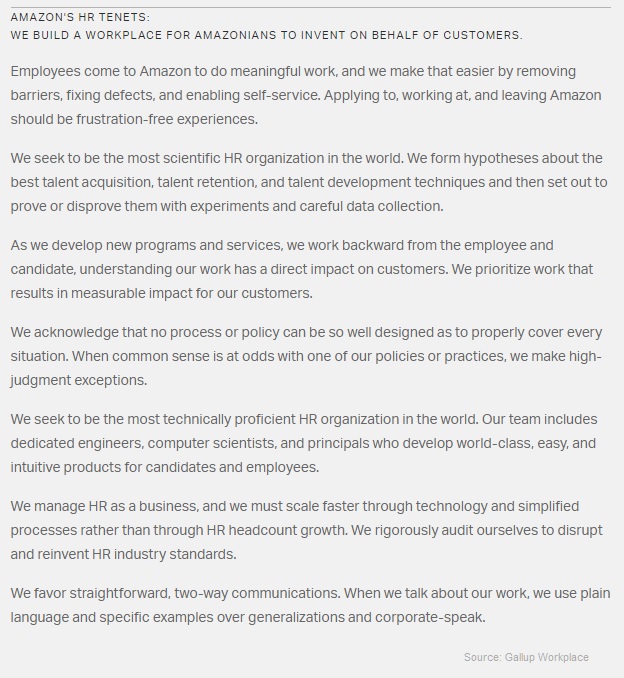Did you know that “becoming scientific” is a strategic goal that is shared by the HR functions of two of the top three most valuable firms in the world? Yes, Amazon’s goal is to “Become the most scientific HR organization in the world,” and Google’s goal is to become as scientific as their engineering functions by bringing “The same level of rigor to people-decisions that we do to engineering decisions.”
Other business functions have already shifted to the scientific model
Sadly, HR must play a game of catch-up because all other business functions including production, marketing, finance and supply chain long ago shifted to a scientific model. It’s almost impossible to find a global firm with an HR function with the goal of “becoming scientific.” The real news may be that these two stellar performing firms (Amazon and Google) starkly stand alone as striving to make their HR function totally scientific, data-driven and precise.
Technology and AI have finally begun to drive HR. Our leaders must now start to realize that no HR department will ever be able to make the transition into a digital, AI and technology driven HR function until they first commit to make all HR decision-making as precise and scientific as engineering decisions. In my view, that means that the dated argument over whether HR management is a science or an art is now over. The remaining 99% of HR functions (including your firm) will soon be forced to adopt this data-driven “scientific HR” approach.
Highlighting the differences between “Scientific HR” and traditional HR
Traditionally, all HR functions have relied heavily on the use of past practices. And although these practices probably once reflected the most effective approach, they are probably still used even though the business environment, the technology and even the workforce assumptions under which they were created may have changed dramatically. In contrast, “Scientific HR” assumes continuous change, so it uses data and facts to shift towards the latest, most effective HR approaches continually. So, if you are considering following the lead of Amazon and Google to become a scientific HR function, here are 9 defining characteristics that are the foundation of that model (the most impactful ones first).
HR directly impacts business results. As Amazon puts it, “We manage HR as a business.” So, rather than simply “aligning with business goals,” the scientific model focuses on HR actions and resources so that they produce the maximum direct, measurable impact on business results.
The two primary areas where HR can traditionally produce the highest business impacts include increasing the productivity of the workforce and improving the volume and speed of product and process innovation. Under this scientific approach, HR focuses on solving broad strategic business problems (e.g., decreased sales, product development or missed deadlines) rather than tactical HR problems. And finally, under this model, HR problems and results are converted to their dollar impact on revenue (e.g., the retention efforts on salespeople allowed us to maintain $2.5 million in sales revenue). Reporting results in revenue impact dollars allow executives to quickly compare HR’s dollar impacts to those from other business functions.
HR relies on data-driven decision-making rather than relying on past practices or intuition. Under the scientific model important people management decisions are made based on performance data. Decisions on the most effective approaches for hiring, retention, development and incentives are based on the latest available data. Data and objective criteria are also used to determine when needed work should be done by employees, outsourced labor or using technology. Other organizations that have made significant strides in data-driven decision-making include Sodexo, UPS and the U.S. Army.
HR emphasizes hypothesis testing and experimentation — Perhaps the most prominent difference between traditional and scientific HR is the emphasis on experimentation to test more effective approaches. For example, a split-sample experiment could prove or disprove the hypothesis: “Diverse interviewers select more diverse candidates” (They don’t).
Google HR has long been a supporter of hypothesis testing, especially covering the factors that actually predict new-hire success. Amazon includes its focus on hypothesis testing in one of its HR Tenets, “We form hypotheses about the best talent acquisition, talent retention, and talent development techniques and then set out to prove or disprove them with experiments and careful data collection.”
HR requires continuous learning and improvement — In a fast-changing world, continuous improvement is an absolute necessity. As a result, the scientific approach to HR emphasizes the continuous collection and the reporting of performance data for human decision-making. Machine learning and automatic feedback are also critical for identifying key learnings across broad but interrelated areas that might be missed by humans.
It adds the assumption of HR obsolescence –– Amazon calls it “Learn and Be Curious.” Because in a rapidly evolving world it makes sense to assume that every new and existing process, tool or approach will slowly become less effective and eventually obsolete. And it is a required assumption to simultaneously presume that there are new and more effective approaches that are continually being developed in HR and in other functions that can be adapted by your HR. These assumptions drive the collection of performance data and implementation of experimentation/hypothesis testing for the complete replacement of even new processes and approaches in as little as 18 months.
Everything in HR must be digital – Another Amazon HR goal is “We seek to be the most technically proficient HR organization in the world,” so technology must be a prime driver of HR change. Everything in HR must be digitalized so that all information can be instantly electronically shared among people, processes and machines. Being digital also forces every input and output to be quantified in numbers.
HR prepares for the future – Almost all of HR metrics have been historically focused, while scientific HR focuses on forward-looking predictive analytics. This is because HR can have a much greater business impact if it is future-focused so that there is time to take advantage of opportunities and to mitigate upcoming problems.
Prioritization replaces equal treatment – The use of data eventually reveals that not all people management problems have the same level of business impacts. And as a result, scientific HR requires the function to focus most of its resources on the problems and the solutions that have the highest measurable impact on business results. Business units, employees, jobs and performance are also prioritized.
HR adds an external focus – In addition to HR’s traditional internal tactical focus, HR must also monitor and adapt to the external environment. And that means building a competitive advantage in both HR processes and results over your competitors. The changing external environment also requires HR to build agility into every HR process so that it can rapidly adapt and scale up/down whenever the business environment changes dramatically.
Final thoughts
Many phrases have been used over the years to describe the emerging future of HR. Some have called it digital HR, evidence-based HR or technology driven HR. However, in my view, Amazon’s “Scientific HR” is the most accurate moniker to use. Its basic foundation is to treat people management decision-making as a science rather than an intuitive art. This approach in the short term emphasizes using data for continuous improvement. And in the longer term, it assumes obsolescence because of the continuous and dramatic changes in business and technology. HR leaders should also note that in addition to a significant improvement in business results, becoming more scientific also dramatically improves the credibility of HR leaders among executives.
So, my recommendation is to follow the lead of the amazing firms of Amazon and Google and add “becoming scientific” to your strategic HR goals.
Author’s note: If this article stimulated your thinking and provided you with actionable tips. Please take a minute to follow or connect with Dr. Sullivan on LinkedIn and subscribe to TLNT Daily.
